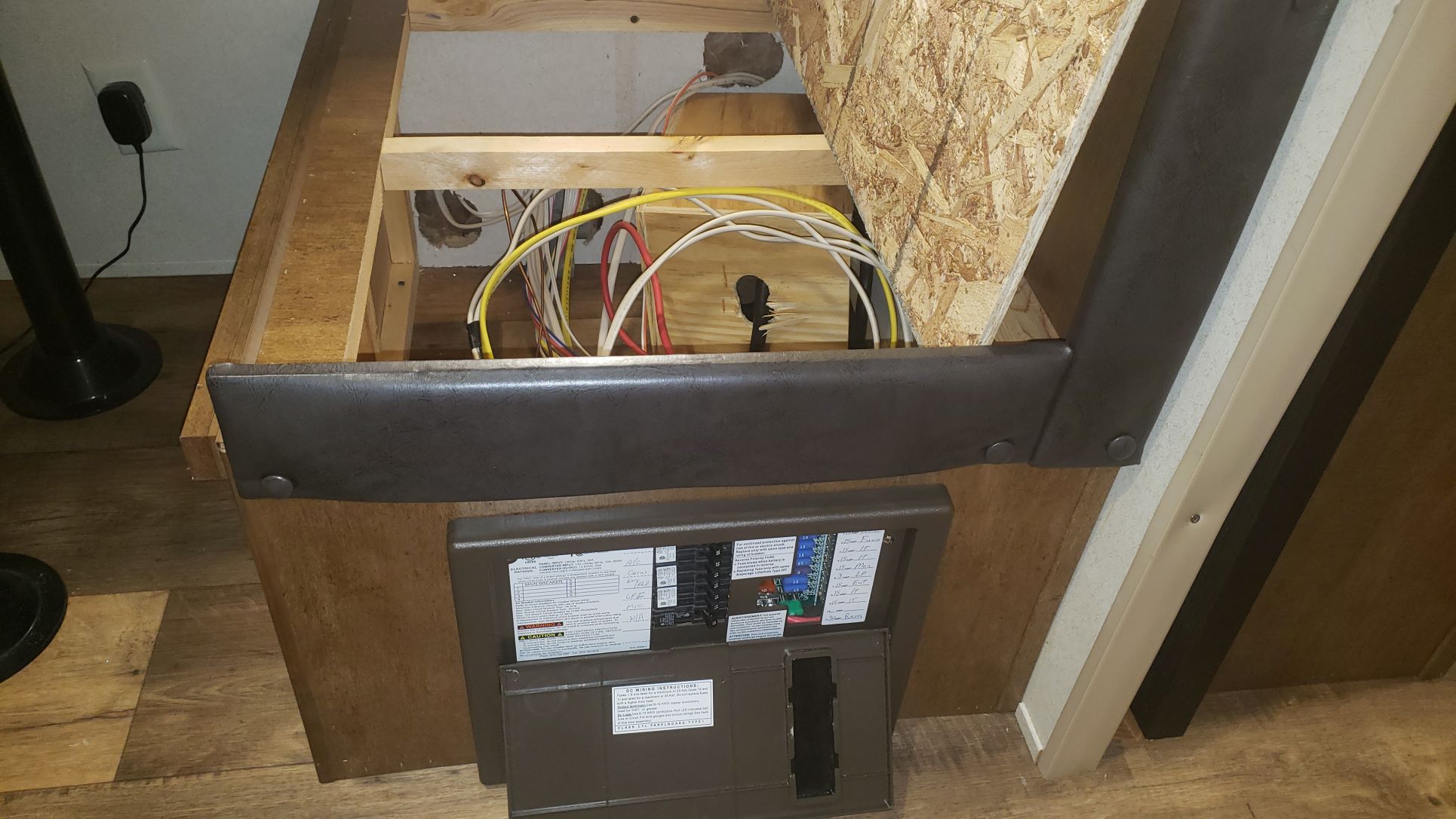Bypassing an RV converter is necessary for certain situations, and doing so safely lets you get the full use of your RV without worrying about damage to other components.
To bypass an RV converter, you need to disconnect its power supply. With an independent converter, flip the breaker to turn it off. Converters integrated into the power distribution center have a black lead to disconnect from the breaker, and you can connect this to its breaker for future use.
This article explains how to locate and bypass the converter in your RV. We also explain why you should bypass the RV converter and situations when you need to seek a different solution.
Bypassing an RV Converter
A professional should make most electric adjustments, including bypassing an RV converter. Still, the process is straightforward enough that you may be able to do it on your own.
Most, if not all, RVs come with a built-in converter. This may be different if you purchased your RV through a third-party or private seller, but you’ll rarely come across a rig without a converter unless someone has bypassed the component.
Before messing with anything, disconnect the RV from shore power. This allows you to safely locate and manipulate the necessary connections to bypass your RV converter.
Locating the Power Converter in Your RV
The converter can be in many different places, but you can usually find it near the control panel. A quick online search can also point you in the right direction, but this won’t work for any modified systems.
Most converters have something to cool them off nearby, so keep an eye out for suspect fans and vents.
You can also try turning off your air conditioning and the lights in your trailer and listening for the converter. Most will buzz just enough to give away their location.
If you’re still having issues, contact the manufacturer or the person you bought the trailer from for assistance.
Cutting Off Power to the RV Converter
There are two ways for your RV converter to connect to your system.
A standalone converter plugs into your electrical system and connects to its own breaker. You should be able to notice this through any wiring that connects it to a specific breaker, or an adequately labeled system will point you to the breaker in question.
All you need to do here is turn it off, and you’ll effectively cut off power to the converter so you can bypass it.
Other converters are wired into the power distribution center. For these, you need to look for the black lead and remove it to cut off the power supply to the converter.
We suggest installing a new circuit and connecting the converter to that circuit in the future so you can turn it on and off if needed.
You don’t need to remove the RV converter when bypassing it. Keeping it around ensures you have a backup plan and can quickly turn it on if the need arises.
Replacing an RV Converter with an Inverter Charger
If you bypass your RV converter, you need to replace it with something that charges your 12V batteries.
The most straightforward solution is installing an inverter charger. This inverter combines with a smart converter, so you get compounded benefits. The inverter charger can:
- Charge your battery bank using shore power
- Run household electronics from the battery bank
- Let you maintain power to 12-V electronics
It takes on the role of both a charger and an inverter, and replacing it with an inverter charger is a simple upgrade that offers benefits beyond both.
Inverter vs. Converter vs. Inverter Charger
An inverter takes the 12V power from your batteries and changes it into 120V power. You’re less likely to see these in the default installation of an RV, and the items they power include:
- Hairdryersrs
- Microwaves
- Coffee makers
The inverter lets you use all 110V electrical sockets in your rig.
A converter is a standard component that converts 120V AC power to 12V DC power. This lets you charge your 12-volt battery packs when connected to shore power or a generator, and it powers items such as:
- Fans
- Vents
- Lights
You may already see the issue with running an inverter and a converter simultaneously. If the converter notices 120V power, it will automatically be set to convert it to charge the batteries. The inverter kicks in simultaneously to convert DC to AC, which results in an endless and inefficient power loop.
This is where an inverter charger comes into play.
The inverter charger combines the functionality of an inverter with that of a smart converter, and it efficiently sends power in both directions. The smart converter switches on and off as needed, so there are no power loops to worry about.
What Type of Inverter Charger do You Need for Your RV
A pure sine wave (PSW) inverter charger is the best choice for your RV. This comes at a higher cost, but it is much more efficient and does not limit what AC devices you can plugin.
Modified sine, or multi-step, wave (MSW) inverter chargers have a choppier delivery. You see a visual representation of this with light bulbs or feel it when running power tools, but this is not the biggest issue.
Bypassing your RC converter to use an inverter charger with MSW puts more advanced electronics at risk. For example, the microprocessor in your laptop needs a clean wave for proper charging. It cannot regulate temperature properly with the choppy supply, and it reduces the lifespan of the devices.
Bypassing the converter for replacement is recommended when you can do it, but it’s best to wait until you can do so properly to avoid major issues.
Reasons to Replace an RV Converter with an Inverter Charger
When you bypass your RV converter and replace it with an inverter charger, you unlock benefits such as:
- Seamless AC and DC power
- Enhancing your off-grid experience
- Automatic transfers and generator starts
The inverter charger is a more advanced piece of equipment, and opting for the combination instead of just a smart charger creates a more comfortable and hand-off environment for you to kick back in.
It reduces the chance of specific issues popping up, and you can focus more on what matters—no need to keep the electrical problems at the back of your mind.
Best of Both Worlds
With an inverter charger, you get the function and benefits of an inverter and a charger. This lets you charge your batteries while supplying AC and DC power to the appropriate appliances.
If you’ve had a system that uses both an inverter and a converter separately, you understand the two cannot run at the same time. This creates messy schedules, so you can charge at a particular time and run appliances at a different time, and the mental stress is no fun.
Even worse is if you accidentally leave both on. You end up draining your battery, leaving you in a bad spot if you don’t notice it.
While you can bypass the RV converter to run the inverter, making the upgrade to an inverter charger gets rid of these headaches and lets you experience the benefits of both.
Better Off-Grid Experiences
If you spend a lot of time boondocking or camping off-grid, an inverter charger is almost necessary. AC appliances are pretty much inaccessible without shore power or an inverter charger, so this is the only way to bring total comfort to your camping experience.
Perhaps off-grid experience shouldn’t rely on appliances, but plenty of people see the merit of having access to more appliances when out in the wild. You probably won’t rely on television for entertainment, but hopping on your laptop to check on work or documents (especially for remote workers) is preferred to being stuck with shore power.
Even if you aren’t sure you’ll need access to AC-powered electronics, it’s better to have the option if you need them.
Automatic Transfer Switch and Generator Start Features
The automatic transfer switch is a great way to keep everything off your mind. Instead of manually turning things on and off like a standard inverter or charger, the inverter charger handles the brain work for you.
Most also have an automatic generator start feature that clicks on when the batteries drop too low. The inverter will signal the generator to turn on, and it runs until the batteries get their fill.
This ensures your battery bank stays full and there are no interruptions with the flow of electricity.
Can You Bypass an RV Converter Without an Inverter Charger?
You can bypass an RV converter without an inverter charger, but the only instance you would need to do this is if you’re using a regular inverter.
There are plenty of situations where someone wants to bypass the converter because they think they have a faulty converter or are noticing higher power draws, but going around the converter is not the solution here.
If you notice or suspect an issue with your electrical system, you need to contact a qualified electrician (ideally someone with RV experience) to diagnose the issue. Bypassing the RV converter will likely exacerbate the issue, and it can create bigger problems down the road (such as a fire).
Don’t forget to check out our Recommended RV Equipment list!
Get a FREE copy of the Go Together Go Far Travel Trailer Hookup and Disconnect Checklist when you sign up for the Go Together Go Far Newsletter!
Want to learn more about different types of RVs? Check out:
- Best Off-Road Camper Trailer Under $10,000
- Best Bunkhouse Travel Trailer Under 30 Feet
- Are Lance Travel Trailers Any Good?
- Do Rope Lights Deter Rodents?
- What Are the Best Names in the RV Industry?
- 3 Best Travel Trailers for Family of Four
- Blue Ox SwayPro Basics: Top Questions Answered
- Adding A Washer Dryer To Travel Trailer? What You Need To Know.
- Best Drone For Camping, Backpacking, and RVing: A Complete Guide to Drones for RVers
- Furniture and RVs – How To Get It Through the Door…
- How To Get Rid Of A Poop Pyramid In RV Black Tank
- Do You Know How Long To Keep Fresh Water In RV Tank Storage?
- What Is The Best Outdoor Security Camera System For Your RV?
- RV Bumper Mount Grills: 5 Best Options For Your RV Or Camper
- Best Electric Tankless Water Heater for Your RV. What You Need To Know
- Read Before You Buy! How to Find the Best Scooter for RV Camping
- 3 Best Travel Trailers for Family of Four
- Top RV Brands: What Are the Best Names in the RV Industry?
- Lance Campers: What Makes Them So Different?
- Best Bunkhouse Travel Trailer Under 30 Feet
- Best Off-Road Camper Trailer Under $10,000
- Best Weight Distribution Hitch With Sway Control For Travel Trailers in 2022
- What Are The Best Built Travel Trailers? Things To Consider.
- How Does An RV Refrigerator Work? A Quick Guide.
- Why Does My RV Carbon Monoxide Detector Keep Beeping? A Quick Guide.
- Where Is The Power Converter In My RV Or Travel Trailer
- What is the Best Generator for 50 Amp RV?
- Wireless RV Security Camera Systems: Is Solar Powered Security Without Wi-Fi An Option?
- Best Portable Air Conditioner for Camping for 2022
- How to Find the Best 3500 Watt Inverter Generator for RV Camping
- Best Propane Generator For Your RV: Read This Before You Buy!


